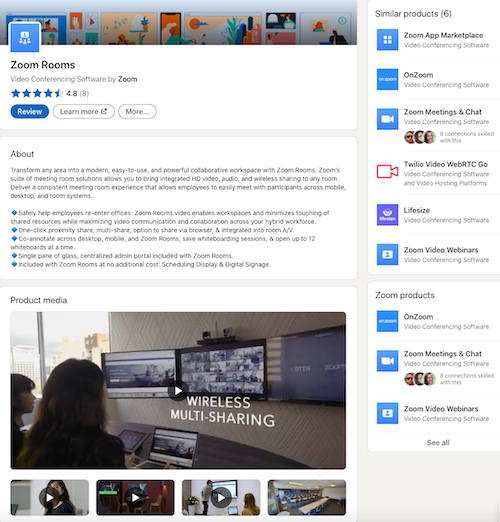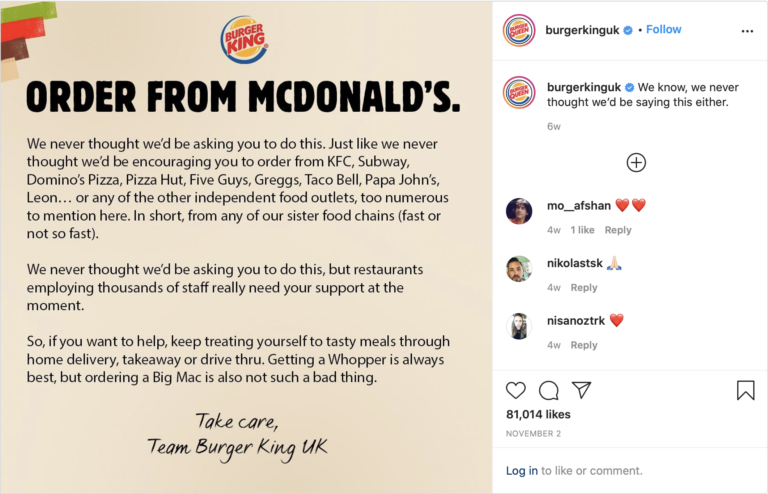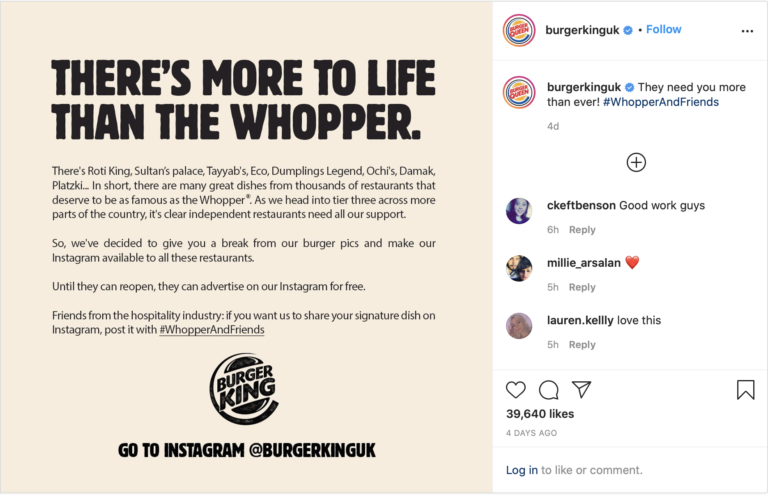Recently, a couple people have asked us what customer experience encompasses and why we select the stories we do for This Week in CX… afterall, they really run the gamut! From news about advertising campaigns to product development, rebrands, research, and algorithm updates, they speak to every sector of a company’s business and growth milestones. But the reason for that is quite simple: Every single interaction and/or touchpoint a potential or existing consumer or client has with your brand factors into your overall customer experience. The quality of the experience – whether it’s friction-less and purpose-driven, or full of frustrating, confusing, or triggering moments – continuously informs and evolves a customer’s perspective and affinity for your brand.
And the minute details – the words and images used in the messaging, the colors chosen for design, the tools used to deliver customization and personalization, the ease of navigation and product design, the foresights into changing consumer behaviors and expectations, the optimization that enables discovery and education – it all impacts a customer or consumer group’s experience with you. Like we always say, #ExperienceIsEverything.
Extreme care and intention must be carved into every business decision made, whether it obviously impacts the external customer, or not (because hint: employees are the drivers of experience and if they’re not happy, we bet you’ll notice a trickle-down effect). Cross-functional alignment on values, purpose, mission, voice, and personality is essential to providing consistent experiences that build rapport, dependability, and advocacy.
Also read: How to Craft Employee Experiences That Improve Customer Experiences
Hopefully, with that explanation, we’ve made our why behind the stories we choose a little easier to understand (if you’re still confused, we’d love to continue the conversation! Send us a DM here, here, or here). So, without further ado, here are the biggest product, marketing, and research developments that occurred this past week and will most certainly inform how we design and deliver the customer experiences of tomorrow.
The quality of the experience – whether it’s friction-less and purpose-driven, or full of frustrating, confusing, or triggering moments – continuously informs and evolves a customer’s perspective and affinity for your brand.
One Milk Alternative Brand Took Transparency to an Udderly Risky Level (Or Did They?)
Companies by and large have had to get creative with their marketing efforts as work-from-home and social distancing mandates have continued as our new normal. For example:
Apple released a commercial that showcases a slideshow of photos and videos – safe to guess all shot on iPhones – with the message, “Creativity goes on.” While simple, it does the job. Some of us may or may not have felt a little choked up.
Women’s Aid – a UK-based organization that provides live-saving services to those impacted by domestic abuse – took to the streets to capture footage of empty sidewalks, parks, stripmalls and sqaures. In between the commercial’s montage, simple white letters appear on a black screen that read, “Domestic abusers are no longer walking among us. They’re locked inside with their families.” A sobering reminder and plea to donate to help women and children in our communities whose homes are anything but safe.
Coors Light turned one Grandma’s tweet into a massive social campaign (and free beer spree) that ultimately raised brand awareness and customer sentiment. After 93-year old Olive Veronesi posted a photo with a beer can in one hand and a sign in the other that read, “I need more beer!”, Coors was quick to jump into action.
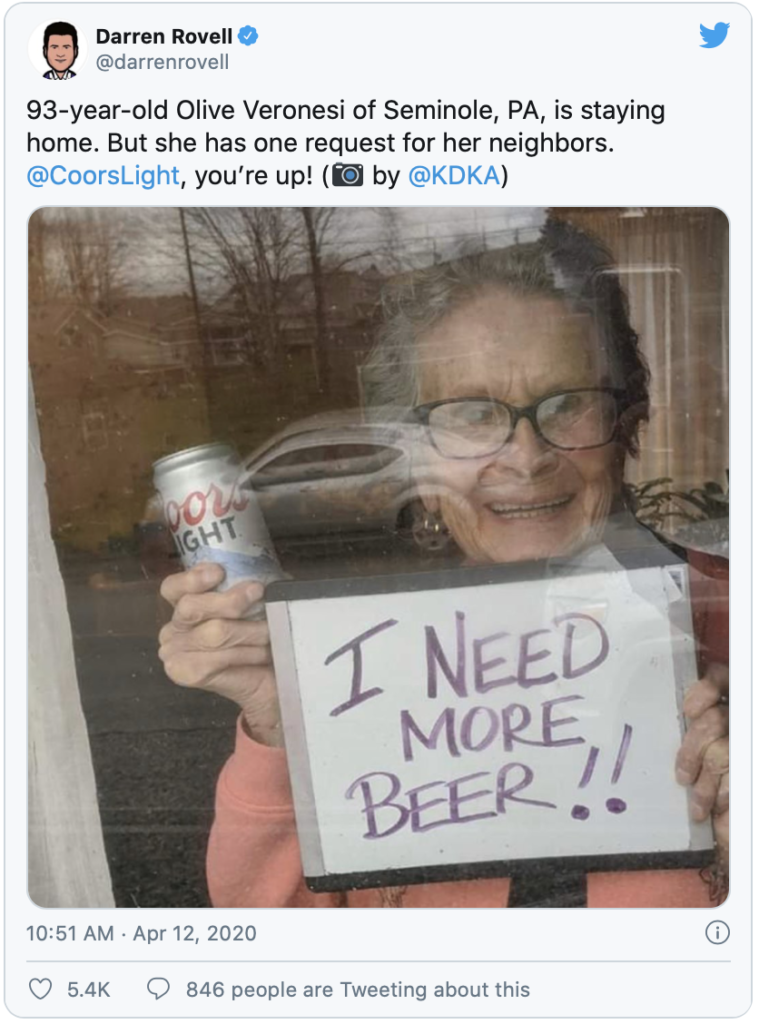
They delivered 10 cases to Olive’s doorstep (to which she posted another picture with an updated sign, “Got More Beer!”) and started a Twitter giveaway – one that resulted in dropping off a whopping 500,000 beers to people’s doorsteps – with the #CouldUseABeer hashtag.
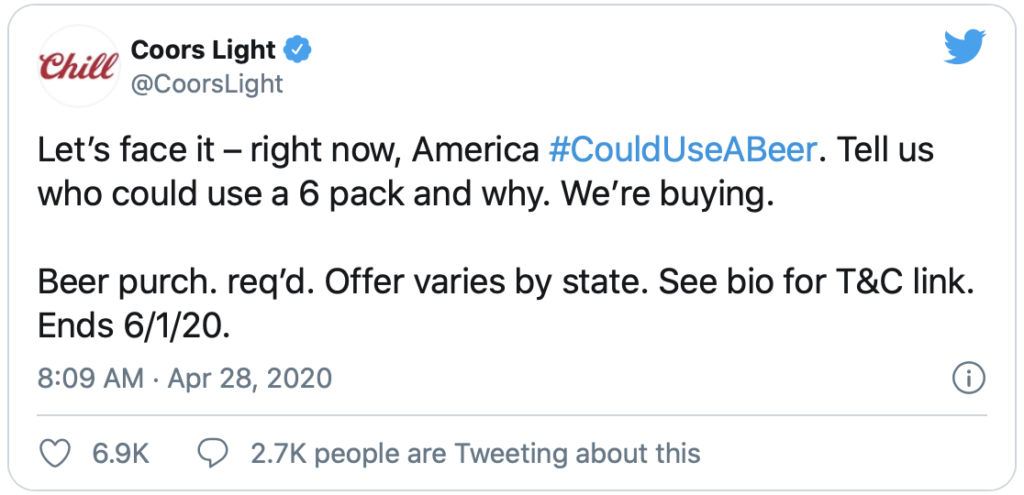
So, with creative ad campaigns piling up, what’s a new brand – who can’t supply samples in grocery stores to potential consumers but wants to make a splash in the marketplace – to do? Lean in, take risks, and follow the lead of the unconventional.
Milkadamia, a new nut-based milk alternative brand, introduced itself with a little transparency and light-heartedness. Afterall, we’ve all had a very serious year. They recruited seven Chicago-based comedians and sent them boxes of unidentified food items. The comedians (read: not scripted actors) were told to unbox the items and try them. On-camera. That’s it.
They called it the “Just One Taste LIVE campaign” and, while they aimed for authentic reviews of their products – ”I won’t say I wasn’t anxious,” CMO Christina Downey said – they also did some good by paying out-of-work improv actors to sit in their PJs and drink Milkadamia’s new macadamia nut milk. Although, just to be clear, none of them were actually wearing PJs. They look quite presentable in the final video. Which, come on, making the rest of us sitting in three-day old sweat pants look bad.
The campaign’s goal was to open people’s minds up to the possibility of plant-based milks, and while they may have achieved that, some Tallwave experts felt the campaign fell a little flat.
“The idea is good… But to be totally honest, the video feels kind of forced,” reviews our Manager of Content Strategy Holly Ringerud. “I know they said it was unscripted, but it’s obviously edited and everyone is well-lit. It’s just not as high concept or entertaining as I think it could have been.”
She finished: “But it’s an interesting update on the ol’ taste test!”
So, there’s that.
Our Director of Operations Kailen Campbell also loved the idea but was left wanting more. The biggest problem? It didn’t stay true to the campaign’s name and promise.
“The video campaign says it was ‘recorded for subsequent public distribution,’ right? So, this was not truly a live event – despite being called ‘Just One Taste LIVE’ – where people like me could join the Zoom and watch the big names taste everything in real-time,” Kailen pointed out. “Believability matters a whole lot with things like this.”
She did have some kudos to give.
“Creative? Totally! Unique? Yep. Good for them for giving us all something a little different.”
But it was actually another Milkadamia video that sparked greater interest in the brand and product for Kailen.
“I actually really enjoyed the educational promotional video more. I don’t know much about milk alternatives. I drink cow’s milk! So, the educational information made more of a lasting impression on me.”
It seems unanimous. A for creativity. A for taste. C for execution. Sorry, we can nut lie.
Facial Masks Get a High-Tech Makeover
Bonatone, a British electronics firm, recently released a high-tech, protective face mask that solves a pain point all mask-wearers have encountered at least once. With earbuds and a microphone built-in, Maskfone gives multitaskers the power to stay safe while continuing conversations – or listening to music, podcasts, etc. – while on the go. As CreativeBloq [https://www.creativebloq.com/news/maskfone-ultimate-face-mask] put it, “Anyone who has tried removing a mask with music plugged in will know it’s a recipe for lost earbuds, while trying to speak on the phone through a mask is a recipe for a sore throat.”
Simply put: Bronatone developed a product with hopes of changing the experience humans have with their protective masks, whether on a jog, at the grocery store, or taking a professional call while chasing a kid around Target.
But the real question of the hour: How has the pandemic changed people’s perceptions of crowds, germs, and distancing, and will newly-acquired safety-precautions – like wearing masks – continue once the threat of COVID-19 has passed?
“I think people will be more mindful about cleanliness – continuing to use hand sanitizers and wipes – while in public places and crowds. Companies may continue to offer sanitizing products to the public. I also foresee virtual experiences, such as Telehealth and contactless options continuing,” says Jenny Alexander, Product Designer at Tallwave. “But I definitely don’t see the use of masks persisting once the pandemic is resolved. There is already a lot of resistance to wearing them. Potentially a few extra cautious people may prefer wearing masks, but I only see the trend lasting for a short period in the post-pandemic world.”
Well, hopefully for Bronatone’s sake, the mask – which is made with four filter layers, washable and water-resistant fabric, comes with a variety of ear hook sizes and features controls buttons on the side, along with an app that can boost the speaker’s voice – sells out before we all go back to living the unmasked life.
Also read: How to Brainstorm For Innovation
Speaking of COVID-inspired items… Has anyone created the bottomless toilet roll yet? Now, that’s a life-changing invention right there.
New Survey Reveals New Charitable Donor Insights
Data Axle released a new report titled New Best Practices to Connect With Today’s Charity Donors that highlights current behaviors, preferences, and sentiment among today’s charitable donors, particularly as they vary by age, gender, income and political affiliations.
Being that we work closely with a couple nonprofits and charitable organizations to improve their donor acquisition, digital footprint, and reach new (younger) audiences, we were interested.
"It all comes down to a charity’s customer experience."
Some key takeaways shared in the report include:
- Preferences surrounding donation channels vary by age; 45% of donors 60+ prefer sending donations via mail; while all demographic groups between 18-60 prefer making donations by going to a nonprofit’s website unsolicited and donating online (ahem, a strong digital experience – and digital brand awareness strategy – is key).
- Young donors (18-44) favor making monthly contributions to charities of their choice – it’s all about ease through recurring (subscription-like) models these days.
- Omnichannel strategies and cross-channel communication is crucial. Email, direct mail, and social media were reported most important – with basically no one wanting to receive phone calls. However, and potentially most important, according to the report, donors prefer to “receive communications via one channel and donate through another, [so] synchronized cross-channel strategy is vital.”
“These findings do align with what we’ve seen through our partnerships and respective campaigns with donor-dependent nonprofit and charitable organizations,” says Tallwave Consultant Benjamin Pressman. “It all comes down to a charity’s customer experience. The starting point has to be internal alignment on what success looks like. This evaluation must rely on factoring the lifetime value of new donors into acquisition costs. In our experience, nonprofits can’t rely on each individual acquisition channel delivering a positive return, but instead need to, at a minimum, combine all acquisition and retention efforts’ costs to view the overall lifetime value return. More sophisticated evaluations can be developed to understand the influence each channel has on initial donation and retention of donors, but there needs to be an understanding that all channels contribute to the overall revenue brought in from donors.”
"In our experience, nonprofits can’t rely on each individual acquisition channel delivering a positive return."
And while cross-functional alignment and a defined roadmap for success and ROI is key, so is crafting a personalized, seamless cross-channel experience that encourages donations, as well as engagement and advocacy.
Also read: Optimizing paid media strategies for a 40,000% increase in leads
According to Benjamin (Benjie, as he’s known around the now-virtual office), there are two steps organizations should take to improve their cross-channel experience.
“The first is focusing on the current donor base and finding similar donors:
- Charities should analyze their current donor base and find common factors to acquire similar audiences that provide the needed long-term return in revenue
- Building in audience analytics to the acquisition funnel will also help charities understand where the pain points are in the prospect CX, and test and learn to alleviate those pain points
- Similarly, retention efforts’ pain points should be be evaluated through customer research to inform improvements in retention efforts
These efforts will provide the roadmap to acquiring new donors that align with the existing donor base. Then, charities should use 3rd party research to identify who their new donors likely are. Based on that determination, a new CX flow should be created to accommodate expectations for that audience. This could be a simple tweak of existing creative assets and site content, or a need to more broadly create new experiences.”
Helping nonprofits and charitable organizations expand their reach and deliver their mission to more audiences is something we’re so incredibly proud of and passionate about. We hope to use these new findings to continue that pursuit and drive more unstoppable growth, change, and impact.



